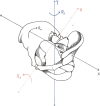Percutaneous screw fixation of the pubic symphysis versus plate osteosynthesis: a biomechanical study
- PMID: 36569108
- PMCID: PMC9782317
- DOI: 10.1097/OI9.0000000000000215
Percutaneous screw fixation of the pubic symphysis versus plate osteosynthesis: a biomechanical study
Abstract
Objectives: To compare the stability of screw fixation with that of plate fixation for symphyseal injuries in a vertically unstable pelvic injury (AO/Tile 61-C1) associated with complete disruption of the sacroiliac joint and the pubic symphysis. Methods: Eight fourth-generation composite pelvis models with sacroiliac and pubic symphyseal disruption (Sawbones, Vashon Island, WA) underwent biomechanical testing simulating static single-leg stance. Four were fixed anteriorly with a symphyseal screw, and 4 with a symphyseal plate. All had single transsacral screw fixation posteriorly. Displacement and rotation were monitored at both sacroiliac joint and pubic symphysis. Results: There was no significant difference between the 2 groups for mean maximum force generated. There was no significant difference in net displacement at both sacroiliac joint and pubic symphysis. There was significantly less rotation but more displacement in the screw group in the Z-axis. The screw group showed increased stiffness compared with the plate group. Conclusions: This is the first biomechanical study to compare screw versus plate symphyseal fixation in a Tile C model. Our biomechanical model using anterior and posterior fixation demonstrates that symphyseal screws may be a viable alternative to classically described symphyseal plating.
Keywords: Tile C; biomechanical; fixation; pelvic ring; pelvis; percutaneous; pubic symphysis; symphyseal fixation.
Copyright © 2022 The Authors. Published by Wolters Kluwer Health, Inc. on behalf of the Orthopaedic Trauma Association.
Conflict of interest statement
The authors have no conflicts of interest.
Figures





References
-
- Lefaivre KA, Starr AJ, Reinert CM. Reduction of displaced pelvic ring disruptions using a pelvic reduction frame. J Orthop Trauma. 2009;23:299–308. - PubMed
-
- Routt ML, Jr, Kregor PJ, Simonian PT, et al. Early results of percutaneous iliosacral screws placed with the patient in the supine position. J Orthop Trauma. 1995;9:207–214. - PubMed
-
- Starr AJ, Nakatani T, Reinert CM, et al. Superior pubic ramus fractures fixed with percutaneous screws: what predicts fixation failure? J Orthop Trauma. 2008;22:81–87. - PubMed
-
- Sems SA, Johnson M, Cole PA, et al. Elevated body mass index increases early complications of surgical treatment of pelvic ring injuries. J Orthop Trauma. 2010;24:309–314. - PubMed
LinkOut - more resources
Full Text Sources
